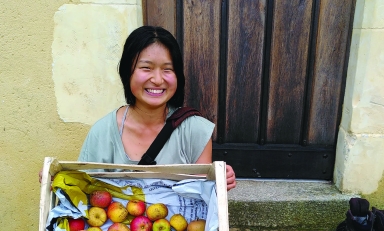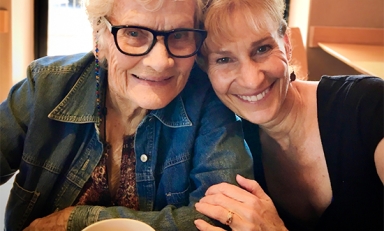
Burroughs & Bacteria: Exploring Print Culture
It's wintertime in Perth, Australia, but it's summer for Tom Mirovski '16. A biochemistry major from Torrance and a Margaret Bundy Scott Scholar at Oxy, Mirovski traveled more than 9,300 miles to study at SymbioticA, an artistic laboratory dedicated to the research, learning, critique, and hands-on engagement with the life sciences. In a recent email to President Veitch, his academic adviser, Mirovski discusses his ongoing work (funded by Occidental's Richter Fellowship) combining the cut-up technique of collage with the configurations of bacteria.
Hi, President Veitch! Hope you're doing well. Sorry I haven't been updating you; my project has been progressing somewhat slowly, since it took a few weeks for my bacteria to arrive before I could begin my work. I've been doing a lot of prep work these past couple weeks (once my co-authors finally arrived), and now I'm nearly ready to begin my actual experiment of imprinting texts onto bacterial cultures. I've also been reading some interesting books and getting some inspiration about how to structure my project, and I'd like to share with you some of the things I've been thinking about.
Since I arrived in Perth, I've been revising the initial plans for my project. My ideas have changed particularly after reading a bit from Deleuze's A Thousand Plateaus, which is absolutely phenomenal and feels like reading Burroughs (although I think Deleuze is critical of Burroughs' aesthetic/non-aesthetic). I've also picked up a couple books on posthumanism that use much of the same language, which has helped me understand Deleuze's vocabulary better (and especially wrap my head around his conception of the multiple).
Anyway, I'm trying to avoid designing this biological cut-up technique simply for the sake of incorporating biological matter into the cut-up method or to just compare its technical design against Burroughs' work. In my writing, I've also been interested in representing the organic and non-organic things (and similar dichotomies) fusing into each other and violating their original distinctions. I think this matches Deleuze's concepts well, and I'm trying to enact the dissolution of those dichotomies in the writing process.
So, in conjunction with the biological cut-up method I'm designing, I'm going to write with the traditional print collage method used by Burroughs and an online generator that uses an algorithm to cut up text. I plan on plugging a couple texts into one technique, write something based off of that text, plug that result and an additional text into a different method, and continue that process of distortion and mutation through multiple rounds in the cut-up machines. I think that it would, in a way, enact a sort of Deleuzean becoming, where the biological becomes digital and textual, the textual becomes digital and biological, and the digital becomes biological and textual.
That, in short, is the basic groundwork I've been attempting to conceive of and articulate these past couple weeks, and I think it adds an additional level of complexity to my original proposal. I'd love any feedback you might have!
I'm still tinkering around with the actual technique I'm trying to develop. I'm updating a blog (tombioart2014.wordpress.com/) with pictures and explanations of what I'm working on. I have red, green, and blue bacteria just like the color scheme on old televisions, which fits perfectly with the thematic of the fusion of the organic and non-organic. My initial plans had included, in a way, to replicate grafitti by spraying certain chemicals through stencils onto bacteria growing in dishes—anyway, I conducted some initial tests and had no luck in achieving that effect. Now, I'm looking into repurposing a typewriter to type onto the bacteria, which should be pretty fascinating in itself.
I've also purchased a couple books from a second-hand book shop to cut up. I've only ever used magazines and print-outs in cut-ups before. I've noticed that, considering the amount of abuse my bacteria have endured—which includes freezing, transferring, growing, and killing these organisms—I feel a lot more apprehensive about cutting up actual books! This disparity between the feelings that emerge from working with organic and inorganic matter is something the artists here at SymbioticA are definitely thinking about (in regards to bioethics and their practice as an aesthetic interaction/performance with biological matter), and I'm definitely going to think about these feelings and their implications further.
SymbioticA is amazing! I wish I could take it back with me to L.A. At the very least I'm going to try sending my bacteria back to Oxy so that I can continue to play around with them, and I also have some future bioart ideas that I'm going to try to get funding for when I return. The community here is completely unique and one of the first of its kind—the director of SymbioticA just got back from Finland, where he's been helping set up another art-science laboratory. The scientists are more than willing to assist and collaborate with the artists working here. I've been having an amazing time talking with the artists about their interests and concerns as pertaining to science and bioart.
Perth is very nice. From the people I've spoken to, it's one of the most isolated cities in the world. It definitely feels smaller and quieter than L.A., except when the birds and crows start croaking and chirping—they're absurd and obnoxious. I prefer cold weather, so I'm glad I'm in Perth during the winter and skipping the summer in California. I've explored a bit of the city with some friends working at SymbioticA, and I also saw kangaroos and emus. I may have also developed a slight coffee addiction last semester—and the coffee here is really quite good.



